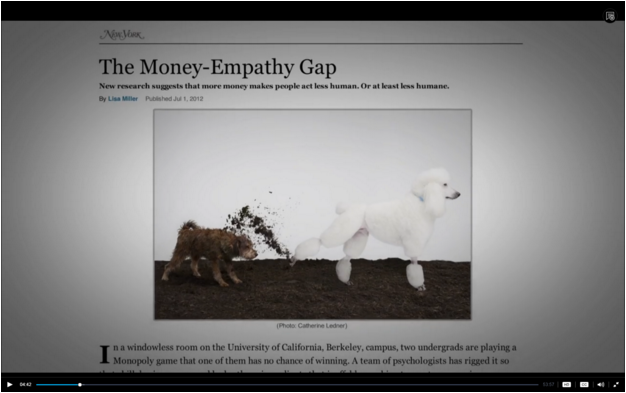MONOPOLY. Digital image. bgr.com. Brad Reed, 27 Jan. 2016. Web. 3 March. 2016.
The “Monopoly Experiment” was done by professional social psychologist Paul Piff to represent America’s economic system, and how the system has different impacts on people of different economic stature. The experiment is set up with 2 players who don’t know each other, and an already set up rigged board to favor one player. There is a “Rich Player” and a “Poor Player”. The “Rich Player” starts with twice the money, can roll an extra die, and collects more money for passing go than the “Poor Player”. Alex Gibney uses the idea of the “Monopoly Experiment” to not only show how everyone has a chance to achieve the “American Dream”, but to also show everyone starts the game with different advantages or disadvantages.
During the “Monopoly Experiment” section of the video Gibney displays the literary devices Normalization and Ethos, and he is able to establish his credibility on the subject, while making it an easy concept for the reader to understand. Economics is a tough topic for an average person to understand, so to Normalize this subject, Gibney uses the simple game of Monopoly to put an Economic system into words that his viewers can understand. It is very important for the viewer to understand the topic that Gibney displays in the “Monopoly Experiment”, because it is the basis of what he talks about for the rest of the video as he transitions between the different topics. Gibney is able to use Paul Piff, a professional reference, as a way to establish his credibility with a professinal source. It’s like we are born into a game of monopoly, where the rules are predetermined, and our money and property is already divided up.

One of the ways Alex Gibney uses the “Monopoly Experiment” in his film is to build his credibility so the “Monopoly Experiment” doesn’t just sound like a rigged game. The experiment was done by the professional social psychologist Paul Piff, who works at University of California Berkley, showing the viewer something that they can really believe. One of the main points that Gibney wants to get across from using the experiment is “There are some in society that have a lot of access, a lot of social mobility, and a lot of resources to do the things that they want, as opposed to other people who are disadvantaged or underprivileged and don’t have the same level of resources.” – Paul Piff (Gibney, 4:23). This applies to the rhetoric device of ethos, which gives credibility to the author. If Gibney just started to talk about a rigged monopoly game, he would just sound crazy, but with the reference of Paul Piff and his experiment, Gibney can establish that he knows what he is talking about, and use the rhetorical device ethos to draw the viewer in more. He is able to use this experiment as a way to get his point across in simple terms, and then through the rest of the video he is able to expand on his main point without confusion.

In this film Alex Gibney uses the “Monopoly Experiment” so his readers have something to connect to through the simple and common game of Monopoly. This is using the rhetorical device of Normalization to allow the reader to get a better understanding of Gibney’s main topic of the video. Not everyone knows a lot about economics, so Gibney puts the complicated idea into monopoly terms, something that’s easy to understand, and makes it simpler for the viewer to get the whole concept. Gibney Normalizes the idea of Entitlement in the experiment by using examples from the actual players in the game. He shows how the rich player feels more “Entitled” because they will eat more of the snacks placed on the table, and would competely disregard how badly the other player was losing. These are simple ideas to get across in monopoly terms, but it gets a bit more complicated looking at the bigger picture with actual rich people. The ending quote of the “Monopoly Experiment” section in the video is Paul Piff saying “The idea of the American dream is that everyone has an equal opportunity, you just have to decide to play. But in fact there are large groups of people that experience the game as unfair, the opportunity is not there, all the rules have been decided, the property has been bought up, and the money is already in the hands of the other players.“ (Gibney, 6:44). This is a good quote to end on, because it’s Gibney’s main point, and it is still in simpler monopoly terms that the reader understands for Normalization.
The “Monopoly Experiment” is just one section of the full video that uses the devices of Normalization to explain everything on a level that your average person can understand, and also Ethos to bring a professional into the video to explain the full experiment, while also establishing his credibility. The experiment is a setup for the rest of the video to give examples of entitlement and politics, while also using more devices, such as pathos and logos. Gibney focuses on giving the viewer something easy to understand, so the rest of this video is easier to understand. Overall the “Monopoly Experiment” is a good representation of his main idea and gives the viewer a good intro to the rest of the video.
